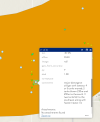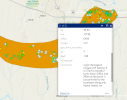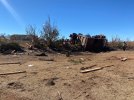Ok thanks for clarifying. I guess my concern about vehicles is that the proposed “Passenger Vehicle” DI was capped at 165 MPH last time we got a sneak peek at the future scale. It makes me wonder if there is some kind of caveat with calculating vehicle movement to confirm EF4 or EF5 intensity? Or are they just playing it really safe, and could higher wind speeds be confirmed using the “Enderlin Method” as I’ll call it?Not necessarily in the "no EF-5" bin yet.
We do have some reports of vehicles being lofted hundreds of yards (Atleast 100 yards, plausibly more) by the Mayfield Tornado, and while I haven't found an exact length of the cars being lofted, as well as a few other DI's like the water tower, it is possible that these could show EF-5 winds. Also, I am working on refining my calculations (For example, the Mayfield train car vs the Tuscaloosa truss bridge). Until then, Mayfield is in the "Possible EF-5" bin.
I do agree with trusting Ethan over myself though. I'm still learning the math but I'm getting better at it!
Navigation
Install the app
How to install the app on iOS
Follow along with the video below to see how to install our site as a web app on your home screen.
Note: This feature may not be available in some browsers.
More options
-
Welcome to TalkWeather! We see you lurking around TalkWeather! Take the extra step and join us today to view attachments, see less ads and maybe even join the discussion. CLICK TO JOIN TALKWEATHER
You are using an out of date browser. It may not display this or other websites correctly.
You should upgrade or use an alternative browser.
You should upgrade or use an alternative browser.
Ozonelayer
Member
Higher windspeeds could be confirmed using the method, as lower windspeeds would have it lofted a shorter distance.Ok thanks for clarifying. I guess my concern about vehicles is that the proposed “Passenger Vehicle” DI was capped at 165 MPH last time we got a sneak peek at the future scale. It makes me wonder if there is some kind of caveat with calculating vehicle movement to confirm EF4 or EF5 intensity? Or are they just playing it really safe, and could higher wind speeds be confirmed using the “Enderlin Method” as I’ll call it?
By the way, that Ford F-150 was lofted an approximate 150-175 Yards. The Ram 1500 was lofted about 175 Yards as well. Insane.
All good! Search up Tim’s PDF of his Vilonia survey. It’s in there. Also, the “15 tons and 3/4 of a mile” is a rough estimate. Here are the exact measurements:Dang I got them mixed up! Could've sworn I heard of something like that about Mayfield. Thank you for correcting the bad info!
Fertilizer tank weight: 13,607 kg
Fertilizer tank distance traveled: 1192 m
joshoctober16
Member
Hi all! New user here.
I'm probably the first Irish person to be on this forum, so that's a cool thing. I decided to finally step into the forum after Enderlin got rated EF5, and get in the ring with all of you. I hope to bring level headed discussion to the forum
That being said, some of the wording from Kevin Laws is absolutely absurd. Tuscaloosa was absolutely a vicious tornado and i have no doubt it was a EF5 given this new precedent and what we're putting into use with the 50 m thing. Those houses between Tuscaloosa in the Holt area give decent credence too, although i am unsure if those were well-built. Would anyone happen to have information on that?
there is a third area to talk about but for a different reason for tuscaloosa.
there is a type of damage and area that got rated EF5 in the joplin tornado but not the tuscaloosa tornado.
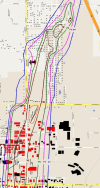
joplin by tim marshall , rated debris streak as EF5
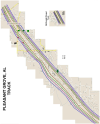
Tuscaloosa by tim marshall , did not rate the debris streaks as EF5
joshoctober16
Member
here is a list of tornadoes that threw vehicles more then 1 km away (there is quite a lot of events of being thrown 50-999 meters so ima ignore them for now)
before 2007
Tornadoes that threw them so far that they were never found OR they were torn in such small parts no one could see it was a vehicle
before 2007
before 2007
- Niles - Hubbard - Wheatland F5 May 1985 | 1+ mile
- Stratton - McCook F4 June 1990 | 1+ mile
- Haysville - Andover F5+ April 1991 | 1+ KM
- Bridge creek - Newcastle - Moore F5+ May 1999 | 1+ mile
- Loyal Valley F4+ May 1999 | 1+ KM
- Wren EF3+ April 2011 | 1.7+ mile
- El reno - Piedmont - Guthrie EF5 May 2011 | 1+ mile
- Rochelle EF4+ April 2015 | 1+ mile
- Cisco EF3 May 2015 | 1+ mile
- Capitol EF3 June 2018 | 1+ mile
- Lake City EF3+ April 2025 | 1+ mile
Tornadoes that threw them so far that they were never found OR they were torn in such small parts no one could see it was a vehicle
before 2007
- Jarrell F5+ May 1997
- Chaoyang City EFU June 2005
- Smithville - Hodges EF5 April 2011 (one was over a mile)
- Hackleburg - Phil campbell - Athens EF5 April 2011
- Joplin - Duquesne EF5 May 2011 (there were a lot of 200+ meter ones as well)
- Henryville EF4+ March 2012
- Vilonia - Mayflower EF4+ April 2014
joshoctober16
Member
This whole thing being contingent on the assumption of only horizontal winds is definitely a notable flaw in the method. At the same time, it is worth considering how much of a tornado's winds actually are vertical very close to the surface, which is a highly variable factor that probably depends on the nature of the tornado and its sub-vortices.
Repost from the event thread, but worth noting that there were 2 houses that were upgraded to EF4 with Enderlin and 2 instances of extreme tree damage that were also upgraded to EF4. Kind of opening the door for additional reanalyses of other tornadoes, not just with the EF5 upgrade.
N0mz
Member
Repost from the event thread, but worth noting that there were 2 houses that were upgraded to EF4 with Enderlin and 2 instances of extreme tree damage that were also upgraded to EF4. Kind of opening the door for additional reanalyses of other tornadoes, not just with the EF5 upgrade.
Yeah I have a feeling those wouldn’t have been upgraded if it weren’t for the extensive review on the train car. By the letter of the law and rating norms, those should never have sniffed EF4-180.
Regarding the “nature of the tornado”, theoretically, would a drill-bit tornado or a very tight and intense embedded sub-vortex have more of a vertical/lofting component than say, a big solid mile-wide wedge?This whole thing being contingent on the assumption of only horizontal winds is definitely a notable flaw in the method. At the same time, it is worth considering how much of a tornado's winds actually are vertical very close to the surface, which is a highly variable factor that probably depends on the nature of the tornado and its sub-vortices.
I was alluding to this in my earlier comment regarding the Pasadena-Deer Park EF3. It produced disproportionately violent tossing and mangling of vehicles in a school parking lot while simultaneously only causing EF2 damage to buildings. That was a multi-vortex tornado. Same thing with the Gary EF3 earlier this year. The damage to that slider farmhouse and trees wasn’t that violent, but cars got absolutely launched and mangled. That one was a drill-bit.
I’m probably not explaining my question well, but essentially, are certain “types” of tornadoes more likely produce disproportionately intense vertical velocity compared to their horizontal wind speed, and have more of a tendency to launch and loft objects as a result?
If so, I could see this complicating things.
My thought is probably yes.Regarding the “nature of the tornado”, theoretically, would a drill-bit tornado or a very tight and intense embedded sub-vortex have more of a vertical/lofting component than say, a big solid mile-wide wedge?
I was alluding to this in my earlier comment regarding the Pasadena-Deer Park EF3. It produced disproportionately violent tossing and mangling of vehicles in a school parking lot while simultaneously only causing EF2 damage to buildings. That was a multi-vortex tornado. Same thing with the Gary EF3 earlier this year. The damage to that slider farmhouse and trees wasn’t that violent, but cars got absolutely launched and mangled. That one was a drill-bit.
I’m probably not explaining my question well, but essentially, are certain “types” of tornadoes more likely produce disproportionately intense vertical velocity compared to their horizontal wind speed, and have more of a tendency to launch and loft objects as a result?
If so, I could see this complicating things.
Coincidentally, a relevant paper was just put in EOL release by Wakimoto et al. regarding kinematic structures of tornadoes: https://journals.ametsoc.org/view/journals/mwre/aop/MWR-D-24-0176.1/MWR-D-24-0176.1.pdf
At some point you have to admit though that the three dimensional components of a tornado's wind velocity is, well, part of its wind speed at a given point and not just the horizontal wind velocities. The wind speed at a given point is thus √(u^2 + v^2 + w^2) and not just √(u^2 + v^2).
Last edited:
While on the topic of inconsistencies between structural and vehicle damage, another absolute head-scratcher is the May 24, 2015 Ensign, KS tornado. It was a big nocturnal wedge and it hit an isolated house, inflicting EF2 damage. However, a car was lifted from the driveway and hurled into the air, over a nearby road, and landed in a field 100 yards away. There were reportedly no skid or impact marks from the car as it traveled, but the damage to the home was nowhere close to violent. The house was just a regular old wood frame farm home too. How does that even happen? Did a violent sub-vortex snag the car from the driveway while skirting the house itself? That’s really the only explanation I can think of.
Vehicle behavior in tornadoes can be very wonky and unpredictable.
Vehicle behavior in tornadoes can be very wonky and unpredictable.
That is actually a very good point.My thought is probably yes.
Coincidentally, a relevant paper was just put in EOL release by Wakimoto et al. regarding kinematic structures of tornadoes: https://journals.ametsoc.org/view/journals/mwre/aop/MWR-D-24-0176.1/MWR-D-24-0176.1.pdf
At some point you have to admit though that the three dimensional components of a tornado's wind velocity is, well, part of its wind speed at a given point and not just the horizontal wind velocities. The wind speed at a given point is thus √(u^2 + v^2 + w^2) and not just √(u^2 + v^2).
Also, really interesting paper, and it’s especially great to see photogrammetry being utilized.
WeathermanLeprechaun
Member
I've always been skeptical of the Cheyenne, OK EF2 and its rating, because these photos contextually suggest a intense tornado at peak. A good analog is the 3/8/10 Hammon, OK EF2 as this also hit the SE side of town, and was likely stronger then EF2 at some point in its life although not as intense as Cheyenne.
Attachments
tornado examiner
Member
October really going down in history this year.
tornado examiner
Member
Hold on, if the lake city Arkansas tornado is upgraded to EF4 (unlikely) but could that be a wild statistic for the modern era.
An EF4+ tornado occurring in every month four months in a row?
3 in March. (Franklin AR, Diaz AR, tylertown MS)
Potentially 1 in April (lake city pending)
2 in may (Marion IL, London KY)
1 in June (enderlin ND)
An EF4+ tornado occurring in every month four months in a row?
3 in March. (Franklin AR, Diaz AR, tylertown MS)
Potentially 1 in April (lake city pending)
2 in may (Marion IL, London KY)
1 in June (enderlin ND)
There was some stubbing and debarking too. I’ve always thought that Cheyenne should have been upgraded to EF3. Usually NWS Norman does a very good job with surveys (barring Goldsby and Chickasha obviously, but that may change) and can be almost questionably liberal as of late, so I was very surprised to see them leave this one at EF2.I've always been skeptical of the Cheyenne, OK EF2 and its rating, because these photos contextually suggest an intense tornado at peak. A good analog is the 3/8/10 Hammon, OK EF2 as this also hit the SE side of town, and was likely stronger then EF2 at some point in its life although not as intense as Cheyenne.
tornado examiner
Member
I have seen literally nobody mention the Ashby Nebraska EF2 from earlier this year yet and that is surprising. That thing completely derailed numerous train cars and the locomotive itself of a very long train but it was not included anywhere in the official survey.
I don’t know what the specifics of that one are but it would be very nice if someone could get on that. I don’t have the math skills to figure it out myself.
And figure out if that one would be worthy of an upgrade.
The locomotive itself weighed 220 TONS. 420k pounds. and it was knocked over by that wedge. Someone please get me the wind speeds for that i’d love to see it. I'm watching a youtube video going over it.
That locomotive alone was Around double the weight of the fully loaded grain car’s derailed by the enderlin tornado that were rated EF5.
By all metrics the Ashby Nebraska tornado should also be rated EF5 if this study and this science is to be adhered too.
I'm just gonna say it too the Ashby Nebraska wedge IS an EF5 for me based on this info.
Scratch that, after watching a video I noticed a few things that may poke some holes in this. An electrical box of some kind near by the train looked to be completely undamaged and a few tree’s in the area had less than impressive damage. So, not quite so airtight.
But still extremely impressive and worth doing the calculations for.
I don’t know what the specifics of that one are but it would be very nice if someone could get on that. I don’t have the math skills to figure it out myself.
And figure out if that one would be worthy of an upgrade.
The locomotive itself weighed 220 TONS. 420k pounds. and it was knocked over by that wedge. Someone please get me the wind speeds for that i’d love to see it. I'm watching a youtube video going over it.
That locomotive alone was Around double the weight of the fully loaded grain car’s derailed by the enderlin tornado that were rated EF5.
By all metrics the Ashby Nebraska tornado should also be rated EF5 if this study and this science is to be adhered too.
I'm just gonna say it too the Ashby Nebraska wedge IS an EF5 for me based on this info.
Scratch that, after watching a video I noticed a few things that may poke some holes in this. An electrical box of some kind near by the train looked to be completely undamaged and a few tree’s in the area had less than impressive damage. So, not quite so airtight.
But still extremely impressive and worth doing the calculations for.
Last edited:
I’m absolutely certain that a “skinnier” tornado is more capable of lofting smaller objects, like cars. Ironically, I feel like you can see an example of this in El Reno 2013’s subvortices. I imagine the extraordinary forward speeds of the subvortices also played a significant role as well, perhaps a “sledgehammer effect” but for lofting rather than straight damage. This may be getting too far into conjecture on my part, though.
The vehicle damage was absolutely incredible from that tornado, well into what I would have believed to be EF5 level damage as far as vehicles go, but the ground/tree damage was low end EF4 at best to me. Elie, MB is a good example of an EF5 level drillbit to me, and in the videos you can see it clearly chucking a van hundreds of yards away with little effort.
The vehicle damage was absolutely incredible from that tornado, well into what I would have believed to be EF5 level damage as far as vehicles go, but the ground/tree damage was low end EF4 at best to me. Elie, MB is a good example of an EF5 level drillbit to me, and in the videos you can see it clearly chucking a van hundreds of yards away with little effort.
WeathermanLeprechaun
Member
Yeah, they're a very good office when it comes to surveys but this was a interesting decision on their behalf. There's something about the TX Panhandle and around that SW OK area with surveys that certain offices just seem to overlook a lot and end up giving a lower ratingThere was some stubbing and debarking too. I’ve always thought that Cheyenne should have been upgraded to EF3. Usually NWS Norman does a very good job with surveys (barring Goldsby and Chickasha obviously, but that may change) and can be almost questionably liberal as of late, so I was very surprised to see them leave this one at EF2.

